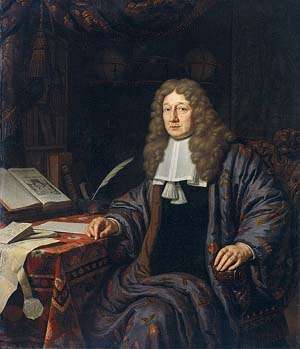Johannes Hudde
| Johannes Hudde | |
|---|---|
|
Johannes van Waveren Hudde | |
| Born |
23 April 1628 Amsterdam |
| Died |
15 April 1704 Amsterdam |
| Fields | Mathematics |
| Academic advisors | Frans van Schooten |
Johannes (van Waveren) Hudde (23 April 1628 – 15 April 1704) was a burgomaster (mayor) of Amsterdam between 1672 – 1703, a mathematician and governor of the Dutch East India Company.
As a "burgemeester" of Amsterdam he ordered that the city canals should be flushed at high tide and that the polluted water of the town "secreten" should be diverted to pits outside the town instead of into the canals. He also promoted hygiene in and around the town's water supply. "Hudde's stones" were marker stones that were used to mark the summer high water level at several points in the city. They later were the foundation for the "NAP", the now Europe-wide system for measuring water levels.
Mathematical work
Hudde studied law at the University of Leiden, but turned to mathematics under the influence of his teacher Frans van Schooten. From 1654 to 1663 he worked under van Schooten and with his fellow students Johan de Witt and Hendrik van Heuraet they translated Descartes's La Géométrie into Latin. Each of the students added to the work. Hudde's contribution consisted of a study on maxima and minima and a theory of equations.
Hudde corresponded with Baruch Spinoza and Christiaan Huygens, Johann Bernoulli, Isaac Newton and Leibniz. Newton and Leibniz mention Hudde many times and used some of his ideas in their own work on infinitesimal calculus.
See also
External links
- O'Connor, John J.; Robertson, Edmund F., "Johannes Hudde", MacTutor History of Mathematics archive, University of St Andrews.
- Johannes Hudde at the Mathematics Genealogy Project
- http://www.gravenopinternet.nl Grave of Hudde in the "Oude kerk" van Amsterdam
- http://www.kwaad.net/NAP-niveau.htm Pagina about NAP and Hudde's stones
- http://turnbull.mcs.st-and.ac.uk/~history///Biographies/Hudde.html Mathematical biography
